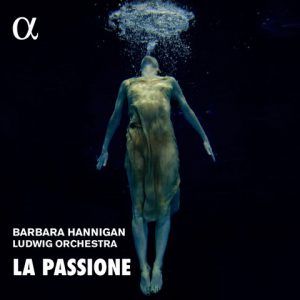Barbara Hannigan “La Passione” (CD Review)

La Passione
La Passione
Barbara Hannigan, soprano and conductor; Ludwig Orchestra
Alpha Classics
La Passione is soprano and conductor Barbara Hannigan’s second CD with Ludwig Orchestra. Their first collaboration, Girl Crazy, won a 2018 Grammy Award. Like Girl Crazy, the selections on La Passione are disparate, but they cohere into a convincing program. Whether she is performing a solo vocal piece by Luigi Nono, conducting a Haydn symphony, or conducting and singing a spectral work by Grisey, Hannigan is a compelling performer. This is also true of Ludwig Orchestra, who thrive in this setting.
Luigi Nono’s solo vocal work Cjamila Boupacha eulogizes a dissident who, during the lead up to the French-Algerian war, was raped and murdered. Her story galvanized anti-colonial resistance in the country. The piece is a vocalize that often accesses the extreme upper register of the soprano’s range. Hannigan navigates its wide range and visceral expressive qualities with eloquence and impeccable technique.
It might seem strange to pair a Haydn symphony with a Nono piece, but Symphony No. 49, “La Passione,” explores grief with depth of feeling and dramatic flair. Composed in 1768, it is one of Haydn’s “Sturm und Drang” pieces. Its formal design is that of a church sonata, with an extensive slow movement preceding the sonata allegro second movement. In terms of both form and demeanor, it may have been played at Esterhazy during Holy Week. The first movement extends a mournful demeanor over a quarter-hour, and it is followed by a combative allegro. Hannigan provides a supple reading of the minuet and trio, with the latter finally allowing the listener let-up from f-minor’s pathos, which has thus far dominated the proceedings, with a glimpse, albeit brief, of F-major. The emotional finale truly embodies the “Sturm und Drang” aesthetic, ending the piece in powerful, albeit tragic, fashion.
French composer Gérard Grisey passed away in 1998 at age 52 from an aneurysm, leaving behind a compact but compelling body of work that helped to define the spectral approach to composition. His last completed piece was Quatre Chants pour Franchir les Soueil (“Four Songs for Crossing the Threshold”), premiered posthumously in 1999. In recent years Hannigan has championed Quatre Chants, notably performing it with Ensemble Intercontemporain conducted by Susanna Mälkki and Sir Simon Rattle conducting the Berlin Philharmonic. On La Passione, she undertakes the daunting task of both singing and conducting the piece. Of the recorded performance with Ludwig Orchestra, Hannigan has remarked, “It took us to our limits.”
A variety of texts are used: Guez-Ricord’s The Hours of Night, Egyptian Sarcophagi of the Middle Empire, a fragment from sixth century Greek poetess Erinna, and an extract from the Babyloninan Epic of Gilgamesh (courtesy Tim Rutherford-Johnson). Overtone chords and micro-tunings abound. The instrumentation is distinctive, particularly the percussion cohort that includes fifteen tuned gongs that are played in quick arpeggiations at a low dynamic level, an impressive feat and singular sound. The bass drum has an evocative role as well, serving to toll a memento mori that divides the piece’s several sections. In the first song, “Death of the Angel”, is one of the piece’s signatures, bracing unison lines between soprano and trumpet that shatter an otherwise merely ominous atmosphere. A variety of wind instruments are employed throughout, including saxophones. Hannigan’s singing seamlessly intermingles with the various instruments, moving from sinuous angular lines to altissimo shrieks with myriad gestures in between. After the four songs is a postlude, “Berceuse,” haunting in its comparative reserve with a number of duets between Hannigan and various instruments in floating vocal lines.
An ambitious program with a “can’t miss” piece (the Grisey) and all of it exquisitely executed: recommended.
-Composer Christian Carey is Associate Professor at Westminster Choir College, Editor at Sequenza 21, and regularly contributes to Tempo, Musical America, and other publications. He has created eighty some compositions for orchestra, choir, solo voices, and chamber musicians. His electronic score for Gilgamesh Variations was produced at Bushwick Starr Theatre in Brooklyn, NY.